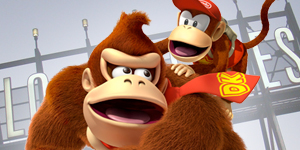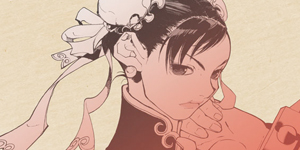Extra: Tales of the Super Mario Bros. Movie
On May 28, 1993, a movie was released that told of a world split in two. The asteroid collision that wiped out the dinosaurs fractured the Earth into a world ruled by mammals and a separate world ruled by reptiles. The dictator of the reptile’s decrepit world wanted to conquer the mammal Earth, but he could only do it with a meteorite shard that hung around the neck of a specific princess. He kidnapped the princess and locked her in the same room as a small, ride-able dinosaur. Little did he know that two brothers, who happen to be plumbers, would foil his plot, get the girl, and save the world. If it weren’t for the names Koopa, Daisy, Yoshi, Mario and Luigi, this description could be for anything. But in reality, what you just read is the synopsis of the infamous Super Mario Bros. movie. To celebrate the 20th anniversary of its release, the team behind Super Mario Bros. The Movie Archive hosted a special screening of the film in Los Angeles. In attendance were not just fans and those eager for a dose of nostalgia, but also four of the film’s creators, who discussed everything that went wrong and the few things that went right.
The backstory of the Super Mario Bros. movie is one that has intrigued both Nintendo fans and movie buffs. How could a blockbuster video game like Mario result in such a poor movie, both in terms of critical response and box office sales? Many of those involved in the film asked that very question upon its release. As special make-up effects supervisor Vincent Guastini put it during the anniversary screening’s Q&A, “I really didn’t know how much of a flop it would be until after it came out… I was kind of surprised because I was like, how could this be a failure? You got Dennis Hopper [Koopa], you have John Leguizamo [Luigi], you have Bob Hoskins [Mario].” Screenwriter Parker Bennett also joked about the movie’s performance by adding, “My own mother walked out of the preview screening saying it was the worst movie she’d ever seen.”

One reason for the failures may have been how detached the movie was from the Mushroom Kingdom that Mario fans knew and loved. This, however, was a conscious choice given the simplicity of the Mario games. “There’s no story there,” Bennett stated at the screening. “You can’t make a movie out of the game. They’d just be running across the screen… We didn’t have a lot to go on.” So what directors Rocky Morton and Annabel Jankel and the screenwriters did was create their own story and then tie in elements from the games. This resulted in the single world split between two dimensions, Bowser reinvented as the humanoid Koopa, and a new emphasis on using evolution (and de-evolution) as a weapon. With those changes came a reptilian world to match, which Bennett described as “modeled after reptilian behavior, so it was very aggressive and dark and twisted.” Given the era the film was produced in, that meant a dingy world not unlike that of Blade Runner. So who better to design it than the art director of Blade Runner itself, David Snyder? Snyder acted as production designer for Super Mario Bros., and during the panel, explained the look of the reptiles’ ‘Dinohattan’ city. He specifically pointed out that it was the script that distanced itself from the video game source material.
“To tell you the truth, I knew nothing about the game, wasn’t interested in the game at the time,” Snyder said. “I was interested in the design of the film based on the script. Whatever is in the script, is what you take as a designer and you follow along to the descriptions of the settings… If there was anything from the game that was integrated into the design, it was by virtue of what was written and handed on to me.” Given what Snyder had to work with, the outcome was actually pretty good. The Mario movie’s filming took over a giant abandoned cement factory in North Carolina and he successfully transformed that into a city that he describes as “sort of fascist, sort of communist” and representative of an “oligarchy government running everything. And that’s who Koopa was.”

Of course, the initial script alone cannot be blamed for the Mario movie’s outcome. There was also the ongoing rewriting of said script, which went on well into the shooting of the movie. According to Bennett, it took numerous writers multiple attempts to create a workable script. First Bennett and his writing partner Terry Runte tried, but as Bennett so gracefully put it at the panel, “we failed.” Then some other writers were brought in, and once again, “they failed.” Finally they passed the responsibility on to Ed Solomon, future writer of Men of Black. As Bennett explained, Solomon “hammered out a draft, I think in a long weekend, and that was mostly shot.” At this point, the movie was already over budget. And once shooting began, the tab kept growing. Bennett and Runte ended up on set during the shooting to make as many cuts to the script as possible in order to keep costs down, which by then had ballooned up to $25 million more than planned. “We did the best we could cutting stuff, and then we were brought back again during looping [re-recording of dialogue] to sort of try to make it make sense because of all the stuff we cut.”
All these cuts and changes not only made for a more confusing story, but also affected other aspects of the film. Snyder’s team in the design department was caught off guard numerous times by the changes. “Each and every day we went in, we were probably working on a different movie,” Snyder joked. “We would design something and it was very laborious and it wasn’t done by CAD, or Photoshop, or Illustrator… We’d be halfway through and they’d say, we’re not doing that anymore.” All of these scrapped designs meant that the “money started to drain out.” Similarly, the visual effects department faced its own ongoing challenges. Visual effects designer/supervisor Chris Woods described how most of the cuts involved scenes that were heavy on special effects due to their cost. In fact, his entire role in the film’s creation was because of budget issues. “I got the chance to do it because I was doing [effects] for far less than other people, and actually put together a digital studio just for the movie so we could do this groundbreaking work for a fraction of what ILM would have charged… But still, it was expensive.”

It also didn’t help that Morton and Jankel were constantly re-envisioning key scenes. “I don’t think I’ve met anyone as consistently creative,” Bennett said of the directors. “They would just have one idea after another. The downside of that is that they would just have one idea after another. As a writer, you’re trying to lock down the structure of the story and how it’s going to work. You come in the next day, and they would be unhappy with the things they agreed to the day before. They would want the ‘new’ new.”
By the tail end of filming, all the constant changes and the ensuing budget cuts caused big headaches as the climatic battle between Mario and Koopa had to be rethought and reduced in both size and scope. “Our original ending had them on the Brooklyn Bridge and doing a giant action sequence there, and we blow up the Twin Towers,” Bennett explained. “Now, in retrospect, I’m glad we didn’t do that.” In the final version of the script, the battle between Mario and Koopa took place in the reptilian world on a much smaller bridge than Brooklyn’s. Yet even then, cuts were made to both save money and ensure the movie was done before its deadline. “Everything that you see there, to me personally is an embarrassment in a way,” Snyder told the crowd, “because it wasn’t how we imagined it would be, it wasn’t what was storyboarded, it wasn’t what was drawn up, it wasn’t what was written. Basically, they said just go in there and just finish.”

By now, the movie sounds like a complete and total disaster both on screen and off. As Bennett pointed out, “There were a lot of constraints, money being primarily the biggest, time, people’s patience. It was 110 degrees in the abandoned cement factory, it didn’t have air conditioning, and there were toxic fumes, and there were a lot of problems.” But even with all these issues, some good still came out of the movie and the panel was quick to note it. Snyder and Woods both spoke highly of the film’s advanced visual effects, the first 35mm film to use an assortment of new digital effects. “It was a seminal work in terms of visual effects and in fact, it was a turning point for people who used optical printers and animation stands,” Woods happily shared. “Within moments after Mario Bros. came out, that gear was all being loaded onto trucks to go to the trash heap and computers took over with pro visual effects. Not singlely by any means, but in large part because of Super Mario Bros’ visual effects.” The film was even nominated for an Academy Award for visual effects. “For a video game to have a lot of digital work in it is perhaps an appropriate aspect,” Woods added.
Beyond it’s impressive (for 1993) visual effects, the creators of the movie also spoke very highly of their time working with each other and the actors. “I was thrilled to work with all those guys,” Woods said. He told one specific story about Bob Hoskins (as well as dispelled long-running rumors of him being drunk on set), who offered to perform a full flip – no stunt double – for the visual effect of transporting between the two dimensions. “In one take, he did this great flip, and that’s what’s in the movie.” In a video sent to Super Mario Bros. The Movie Archive, John Leguizamo also praised his fellow castmates and crew, “I have a lot of fond memories, we had a lot of great times doing [the movie].” Guastini summed up the experience best by saying, “It was probably the most amazing experience of my life… It was like wonderland.”

The Super Mario Bros. movie is a defining film as one of the first video game adaptations, but maybe not entirely in the way its creators had hoped. They did not seem to take any of the negativity personally, though. “I think whenever you go to make a movie, it’s a miracle that it happens at all, and it’s a triple miracle if it’s any good… We did the best we could,” Bennett concluded. Guastini observed that perhaps people just aren’t looking at it in the right light. “After many years of watching, I looked at it from a different perspective, in which it has its own childlike charm. I don’t look at it like it’s a bad movie, I just look at it from a child’s eyes.” But no matter how you look at it, there is no doubt that there are still enjoyable moments in the film. In fact, each of the four panelists had a completely different favorite scene, ranging from the Goombas dancing in an elevator to the car chase through the reptile world. If you haven’t already done so, it’s worth watching the Super Mario Bros. movie just to see this unique piece of Nintendo history. You never know, you may actually like it.




Horrible movie. Luigi without a moustach ? Nonsense. Those enemies are not same as in the video game. Worse movie ever! Thumb down!!!